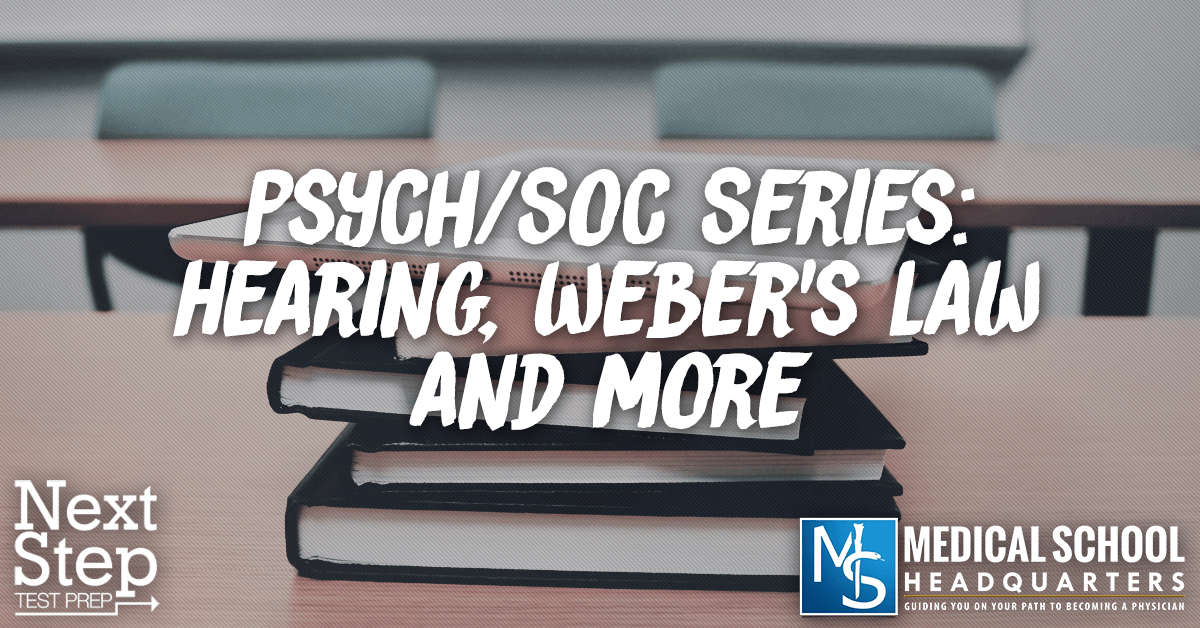You still have time to sign up with one of our amazing expert advisors! Learn More!

This is week one of our Psych/Soc series on the MCAT Podcast. We’re covering some biology questions which is a subject covered in the Psych section of the MCAT. A lot of students struggle with this section because they’re very specific on what you need to know.
Bryan Schnedeker from Blueprint MCAT (formerly Next Step Test Prep) is here, as always, to help us break down these questions for you so you can crush your MCAT come test day! Also make sure to take a listen to all our other podcasts on MedEd Media Network.
Several students have actually been surprised to see biology questions in the Psych/Soc section. They fall for that trap of thinking that all they have to do is study these high yield topics and they’re good to go. But remember that with the sole exception of amino acids, there’s really no such thing as a high yield topic. If you want to do well on any of the science questions, you’ve got to know everything. You’ve got to really cover your bases.
Question 1: Which sequence best describes the pathway used to transmit auditory information in humans?
Bryan’s Insights:
Luckily, I guessed A right and Bryan says it was a “textbook-perfect” reasoning for the MCAT. You use one fact to narrow it down and then eliminate stuff that was the same with the remaining answer choices.
Question: Weber’s Law can be applied to:
Bryan’s Insights:
Weber’s law is also called as the “just noticeable difference” which means that if I present to you two different stimuli, will you say, that’s the same thing or that this stimulus is more or less intense than the other stimulus.
For A, it doesn’t work since you have to have two different tones to detect the different loudness of those two tones. B doesn’t work either since it’s two different participants are each holding their weight. But Weber’s law is about a single person distinguishing between two different stimuli. This means that that the right answer here is C since there’s one observer and two different stimuli. Can the person tell the difference? And that’s Weber’s law.
So theoretically, it can be anything that the human organs of sensation can attempt to distinguish between. The basis of Weber’s law says that the differences are proportional, not absolute. So this could be touch, pressure, weight, vibration, sound, brightness, color – literally anything that you can distinguish between. The idea here is that if you were given two different objects, each of which weighs less than half a pound. And if one is 10% heavier than the other, you’ll be able to tell the difference. Even though that 10% might only be a couple of ounces, you will be able to tell it.
Then you could be given two enormous blocks, one of which weighed 30 pounds and the other weighed 32 pounds. It’s a two-pound difference. With the little weight, you were able to tell two ounces, of course, you can tell two pounds. But Weber’s law says you can’t. Because you picked up the 30 and then you lean over again. Lift with your legs, not with your back. And then you scrunch down and pick up the 32. And you would say they’re the same as each other because the difference between them is less than a 10%. So Weber’s law is not absolute, but it’s proportional differences that we notice.
Question 4: Which of these scenarios exemplify the process of sensory adaptation?
Bryan’s Insights:
Remember when you say sensory, it’s the raw data inputted into your face. As opposed to perception, which then starts to involve higher cognitive processes, what to choose to pay attention to, and your cultural preconceived notions. So perception operates on a much higher level. Sensation is a very kind of raw, biological, mechanical thing.
So sensory adaptation is just an unconscious process. The relevant organs just stopped responding to a particular kind of stimulus. Unlike the child who starts to associate the smell of the dog with comfort rather than fear, you see the association. And that’s a learning process. It’s not just an unconscious adaptation While the pastry chef just stops smelling the food in the kitchen since there’s just less response from the relevant sense organs.
Blueprint MCAT (formerly Next Step Test Prep) has an MCAT course! They used to be known for their one-on-one tutoring, but then last year, they came out with an MCAT course that a lot of students are loving. Sign up for the course and get access to over 100 hours of videos. Get access to all 10 of their full-length exams, all the AAMC materials, and ten hours a week of live office hours where you get to talk to their tutors who know all of the information. By the way, check out the review of their MCAT course that I created which I’ve posted on YouTube. Need MCAT Prep? Save on tutoring, classes, and full-length practice tests by using promo code “MSHQ” for 10% off Next Step full-length practice tests or “MSHQTOC” for $50 off MCAT tutoring or the Next Step MCAT Course at Blueprint MCAT (formerly Next Step Test Prep)!
Blueprint MCAT (formerly Next Step Test Prep)

Lorem ipsum dolor sit amet, consectetur adipiscing elit
I just received my admission to XXXXX! This is unreal and almost feels like I am dreaming. I want to thank you for all of your help with my application. I cannot overstate how influential your guidance and insight have been with this result and I am eternally grateful for your support!
IM SO HAPPY!!!! THANK YOU SO MUCH FOR ALL YOUR HELP, IM INDEBTED TO YOU! Truly, thank you so much for all your help. Thank you doesnt do enough.
I want to take a few moments and thank you for all of your very instructive, kind and consistent feedback and support through my applications and it is your wishes, feedback, and most importantly your blessings that have landed me the acceptance!
I got into XXXXX this morning!!!! It still has not hit me that I will be a doctor now!! Thank you for all your help, your words and motivation have brought me to this point.
I wanted to once again express my heartfelt gratitude for your help in providing feedback during my secondary applications. Your guidance has been instrumental in my journey.
Just wanted to share my wonderful news! I received my first medical school acceptance! Thank you for all that you do for us Application Academy!!!
I am excited to tell you that I just got my third interview invite from XXXXX today! I can’t believe it. I didn’t even know if I was good enough to get one, let alone three – by mid-September. Thank you so much for all of your help and support up to this point; I would not be in this position without it!!
I wanted to thank you for helping me prepare for my XXXXX interview. Even in a 30-minute advising session, I learned so much from you. Thank you for believing in me, and here’s to another potential success story from one of your advisees!
I just received an acceptance with XXXXX! This is so exciting and such a huge relief and so nice to have one of our top choice schools! I also received an interview with XXXXX which brings the total up to 20 interviews! Thank so much, none of this would have been possible without you!

Join our newsletter to stay up to date
* By subscribing you agree to with our Privacy Policy and provide consent to receive updates from our company.
Resources
Advising Services
Podcasts & Youtube
Books
About
Deal Lasts for

"*" indicates required fields